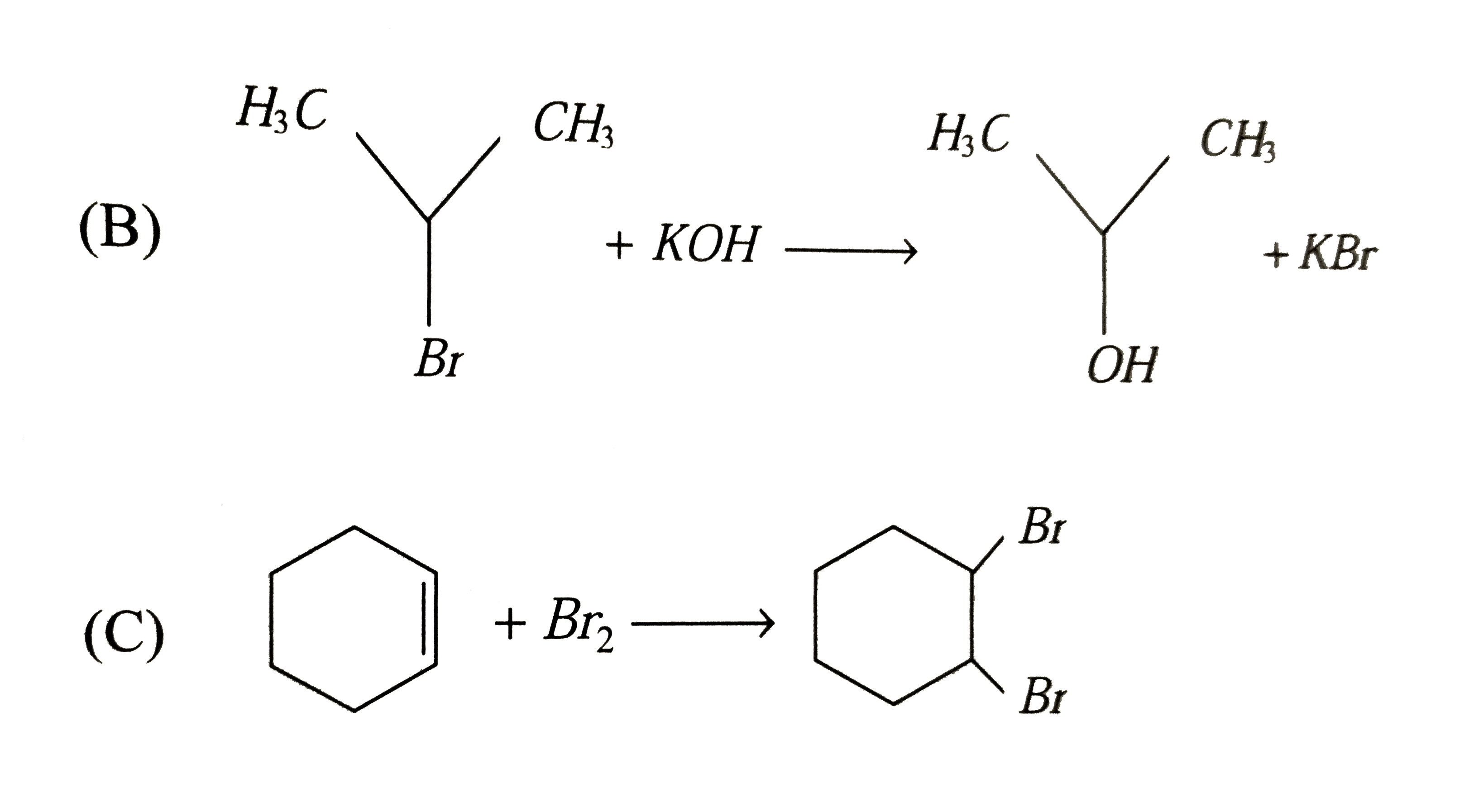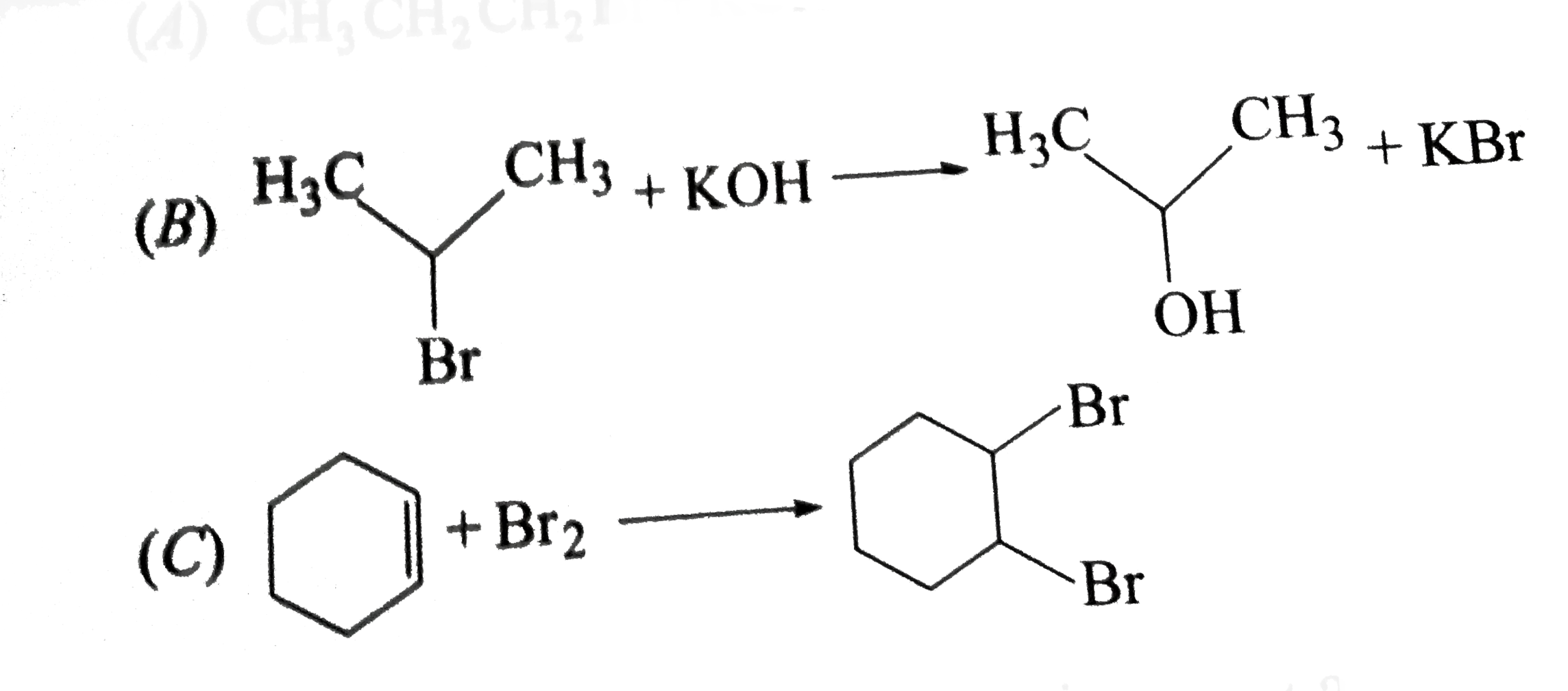CD2 = CH - CH2−Br is subjected to SN1andSN2 reactions separately, which of the following statement is correct ?
both SN1andSN2 give two products
Both SN1andSN2 give only product
SN1 gives two products but SN2 gives only one product
SN1gives one product but SN2 gives two products
The correct Answer is:C
To solve the problem regarding the reactions of the compound CD₂=CH-CH₂Br with SN1 and SN2 mechanisms, we will analyze each reaction step by step.
Step 1: Understand the Structure of the Compound
The given compound is CD₂=CH-CH₂Br. Here, we have a bromine atom (Br) attached to a carbon atom that is part of a double bond.
Step 2: Analyze the SN1 Reaction
1. SN1 Mechanism Overview: The SN1 reaction involves two steps:
- Step 1: The leaving group (Br) departs, forming a carbocation.
- Step 2: A nucleophile attacks the carbocation.
2. Formation of Carbocation: When Br leaves, we form a carbocation. The stability of the carbocation is crucial. In this case, we can have resonance stabilization due to the adjacent double bond. The carbocation formed will be:
- CD₂=CH-CH₂⁺ (with a positive charge on the CH₂ adjacent to the double bond).
3. Possible Products: The nucleophile can attack the carbocation at two different positions:
- Attack at the carbon with the positive charge (leading to one product).
- Attack at the carbon adjacent to the double bond (leading to a different product).
Thus, in the SN1 reaction, we can expect to form two products due to the different positions where the nucleophile can attack.
Step 3: Analyze the SN2 Reaction
1. SN2 Mechanism Overview: The SN2 reaction occurs in a single step where the nucleophile attacks the carbon atom bearing the leaving group (Br) simultaneously as Br leaves.
2. Nucleophile Attack: The nucleophile will attack the carbon that is attached to Br:
- This results in the formation of a single product where the nucleophile replaces Br.
Thus, in the SN2 reaction, we can expect to form only one product since the nucleophile can only attack the carbon attached to Br.
Conclusion
- In the SN1 reaction, we have two products due to the possibility of nucleophile attack at two different positions.
- In the SN2 reaction, we have one product since the nucleophile can only attack one position.
Final Answer
The correct statement is that there are two products in SN1 and one product in SN2.
---
The given compound is CD₂=CH-CH₂Br. Here, we have a bromine atom (Br) attached to a carbon atom that is part of a double bond.
1. SN1 Mechanism Overview: The SN1 reaction involves two steps:
- Step 1: The leaving group (Br) departs, forming a carbocation.
- Step 2: A nucleophile attacks the carbocation.
- CD₂=CH-CH₂⁺ (with a positive charge on the CH₂ adjacent to the double bond).
- Attack at the carbon with the positive charge (leading to one product).
- Attack at the carbon adjacent to the double bond (leading to a different product).
1. SN2 Mechanism Overview: The SN2 reaction occurs in a single step where the nucleophile attacks the carbon atom bearing the leaving group (Br) simultaneously as Br leaves.
- This results in the formation of a single product where the nucleophile replaces Br.
- In the SN1 reaction, we have two products due to the possibility of nucleophile attack at two different positions.
- In the SN2 reaction, we have one product since the nucleophile can only attack one position.
The correct statement is that there are two products in SN1 and one product in SN2.
Topper's Solved these Questions
- HALOALKANES AND HALOARENES Book:AAKASH INSTITUTEChapter:HALOALKANES AND HALOARENES Exercise:ASSIGNMENT SECTION -D
Explore 15 Videos
- HALOALKANES AND HALOARENES Book:AAKASH INSTITUTEChapter:HALOALKANES AND HALOARENES Exercise:ASSIGNMENT SECTION - B
Explore 25 Videos
- GENERAL PRINCIPLES AND PROCESSES OF ISOLATION OF ELEMENTSBook:AAKASH INSTITUTEChapter:GENERAL PRINCIPLES AND PROCESSES OF ISOLATION OF ELEMENTSExercise:Try Yourself
Explore 33 Videos
- HYDROCARBONSBook:AAKASH INSTITUTEChapter:HYDROCARBONSExercise:Assignment(Section - D) (Assertion -Reason Type Question)
Explore 24 Videos
Similar Questions
For the following reactions
(A)CH3CH2CH2Br+KOH→CH3CH=CH2+KBr+H2O

Which of the following statements is correct
View Solution(a) Indicate whether the following are SN1,SN2,E1 or E2 reactions.
(i)CH3CH2CH2CI+I−→
(ii)(CH3)3CBr+CN−(alc.)→
(iii)CH3CH(Br)CH3+OH−(alc.)→
(iv)(CH3)3C−Br+H2O→
(b) Give the decreasing order of reactivity of the alkaline hydrolysis of the following alkyl halides toward (A)SN1(B)SN2(C) in pressure of AgNO3.
(i)(CH3)2C(Br)−C2H5(ii)C5H11Br
(iii)C2H5CH(Br)C2H5
(c) Give the decreasing order reactivity of the alkaline hydrolysis of hte following halides towards SN1(i)MeCI(ii)PhCH2CI(ii)Ph2CHCI(iii)Ph3C−CI.
(d) Determine the relative SN2 reactivity with NaCI in aprotic DMSO of the following alkyl halides :
(A)(i)CH3CHCICH2CH3(ii)CH3CHBrCH2CH3
(iii)CH3CHICH2CH3
(B)(i)CH3CH(CH3)CH2CH2I
(ii)CH3CH(CH3)CHICH3(iii)CH3CI(CH3)CH2CH3
(e) Arrange the following in the order of decreasing nucleophilic character:
H2O,−OH,CH3O−,CH3COO−
(f) Arrange the following in the decreasing order as leaving group in SN reaction:
CH3COO−,C6H5O−,C6H5SO−3,CH3O−
View Solution
Knowledge Check
Which of the following are correct for SN2 reaction?
AThe reaction intermediate is carbocationBIn this reaction the complete inversion takes placeCIt is favoured by polar solventsDIt is favoured by stability of carbocationCH3−C∣Br=CH(2)HBr−−→
Which of the following statements is correct for this reaction?AIt is an electrophilic additionBIt follow Markovnikov rule.CFirst H⊕ attacks on vinyl bromide followed by BrΘ and prodcuts CH3−CBr2−CH3DAll of theseFor the following reaction :
(A)CH3CH2CH2Br+KOH→CH3CH=CH2<br>=KBr +H_(2)O

which of the following statement is correct ?A(A) is elimination (B) and (C) are substitution reactionB(A) is substitution (B) and (C) are addition reactionC(A) and (B) are elimination reaction and (C) is addition reactionD(A) is elimination (B) is substitution and (C) is addition reaction
For the following reactions: (A). CH3CH2CH2Br+KOH(alc)−−→CH3CH=CH2+KBr+H2O
(B).
Which of the following statements is correct?
View Solutionwhich of the following statement is correct for the reactivity in SN2 reaction ?
View SolutionFor the following reaction :
(A)CH3CH2CH2Br+KOH→CH3CH=CH2<br>+KBr +H_(2)O

which of the following statement is correct ?
View SolutionFor the following reaction :
(A)CH3CH2CH2Br+KOH→CH3CH=CH2<br>+KBr +H_(2)O

which of the following statement is correct ?
View SolutionCH3−CH2CH2CH2−CH3CH2N2/Δ−−−−−−→Product
Which of the following product(s)is/are can be abtained in the above reaction.
View Solution